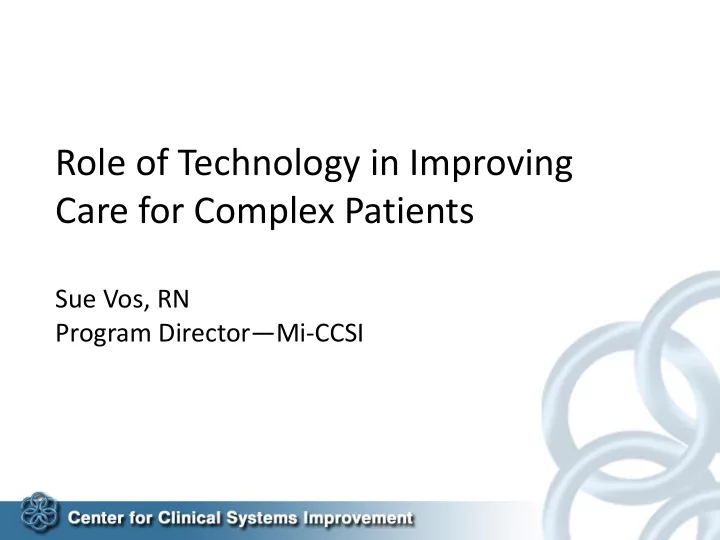

Role of Technology in Improving Care for Complex Patients Sue Vos, RN Program Director — Mi-CCSI
Technical Current State • EMR – Manages individuals - treatment plan • Registry – Population health - gaps in care • HIE – Gateway enabler - ER, inpatient, labs, radiology
Technology Gaps • EMR – Limited to single system/or those using same tool • Registry – Not fully functional or integrated into EMR • HIE – All functions not fully deployed
Making it Real Using technology to help complex patients • Current State • Future State
Laura The person • 68 • Married 45 years to Andy • 4 children, 12 grand children • Seamstress, homemaker, gardener • Safety risk due to short-term memory loss • Withdrawn and little interest in her hobbies
Laura Clinical Presentation • Diabetes, high blood pressure, depression • Multiple ER visits • Lack of control for one or more conditions • Financial challenges • Has family support • Advanced directive completed and on file
Why We Care about Laura
Improving Care for Laura Technology critical to enable care management support of the key functions: – Select - Who – Assess - What – Manage – Getting to goal
Select Risk Management Criteria • Diagnosis: Multiple Chronic Conditions • Data: Access and depth – Payer, EMR/Registry, Inpatient facilities, other (labs, treatments, procedures, radiology, path) • Patient centered: Desire - Ability
Select: Technology Support • Demographics • Quality metrics • Risk screening/assessment • Utilization/Cost of care • Predictive modeling/risk score (payer reports)
Select Use of Technology: Current State Pre-screening and Patient Selection Approaches • Admission Discharge – Some are limited to own systems – Alerted – Alerted with key information (with access to VIPR) • Referrals (Specialist and Community Resources) – Some limited to those with a shared EMR – Ability to send referrals and notice of referral completion • Care Team – Own EMR – If interfaces access to treatments/labs/radiology EMR and or HIE) – Limited payer data (multiple payers – multiple data to interpret)
Ideal State Patient record with full transparency • Multiple Inputs – Patient – Provider(s) – Facilities • A single collaborative plan for managing and optimizing health outcomes and meeting the goals of the patient
Select: Best Practice Approach 1. Review medical and behavioral quality metrics – based on specific criteria 1. Uncontrolled diabetes, high blood pressure, moderate depression 2. Obtain agreement 1. Patient 2. Primary Care Provider 3. Prep for the assessment 1. CM gathers pre-screening data, 2. Conducts a comprehensive assessment 3. Reviews the case with a multi-disciplinary team
Select: Behavioral Medical Integration Start with data (key member of Care team input the team) • Review data with PCP • Determining eligibility • Review program with conditions/diagnosis patient (capture ability • Determine eligibility criteria and desire) • Review the EMR and registry • Define and establish the to confirm criteria dates are roles and responsibilities within evidence base timelines of the multi-disciplinary team • Note and mark start date of • Brainstorming an CM enrollment + interventions effective care plan with inputs from the multi- disciplinary team
Assess Key to risk management • Identify barriers to care – Medical – behavioral – social • Framework for the care plan • Establish patient agreement – Desire and ability
Assess: Care Planning Assessment findings frame the care plan • Data inputs • Care team inputs • Patient/support inputs Establish goals that incorporate treat-to-target measures • Behavioral • Medical • Social
Assess: Outputs • Team approach in determining patients appropriate for high cost intervention of care management – based on population served and management of risk and barriers • Multi-discipline problem-solving and priority setting for the care plan • Defined measures to monitor and determine impact of the intervention/service
Getting There from Here Category Current State Future State Quality Metrics Registry/Registry like EMR Integrated Cost Data Payers (claims) Health systems Notifications of services Payers (Prior authorized) Integrated HIE to system/practice Health system notification Patient Input During the visit Live and frequent input via CM support between visits portals Patient vs. medical record
Getting There From Here Sharing of processes in-place or understood to be in-place • https://www.youtube.com/watch?v=k0xgjUhEG3U Instructions: • Make friends – share patient identification processes within your system/practice/organization. 1. What data feeds would be essential to determine eligibility for high cost interventions such as care management services? 1. Using a scale of 1-10 how would you rate your practice/system today? 2. What data measures will be critical to determine success of high cost interventions? 1. Using the same scale how would you rate this today? 3. What would shared data that is fully transparent look like to a high functioning system?
Manage: Result goals • What is needed? – Claims – RX use/fill rates/cost – Utilization – Patient response to treatment – the secret sauce
Manage: Monitoring and Follow Up Patient-centeredness approach • Challenges/barriers to incorporating the plan of care into living life – Supports, cost, change management
Impact PCMH (PGIP, MiHealth, NCQA, URAC) SIM CPC+ • Focused approach resolves clinical inertia – More rapid quality improvement – matching interventions with treat-to-target approach provides structure & team accountability
Supportive Research
Laura Then Now • 68 • Select: Use of data • Married 45 years to Andy • Assess: Enrolled • 4 children, 12 grand children • Manage: Regular • Seamstress, homemaker, monitoring of data gardener • Results: To goal • Safety risk due to short-term • Diabetes: In control memory loss • Blood pressure: In control • Withdrawn and little interest in her hobbies
Many Thanks • Questions • Input and ideas
Recommend
More recommend